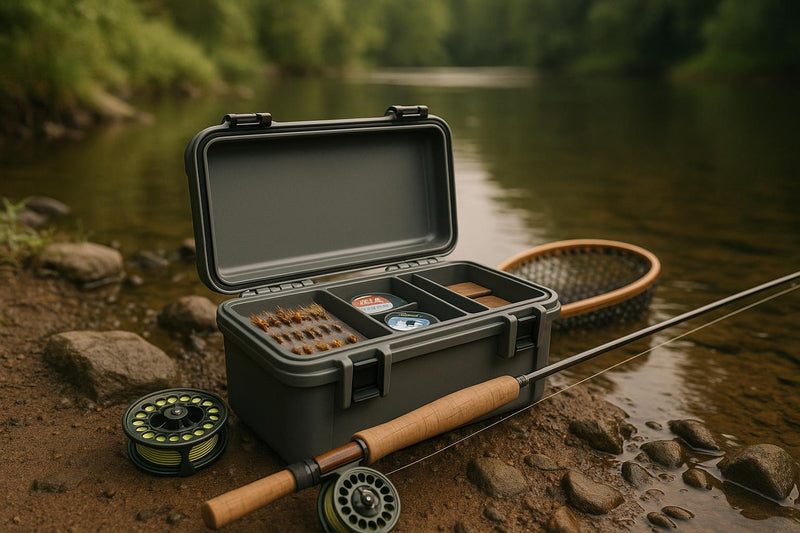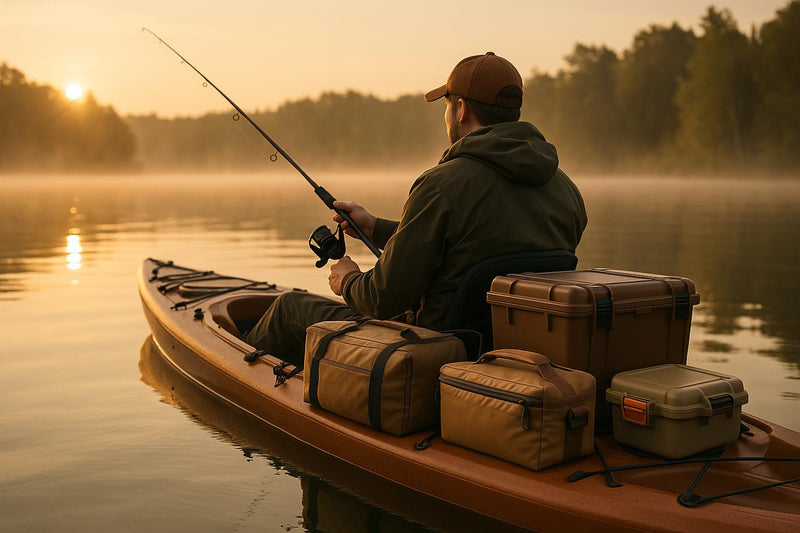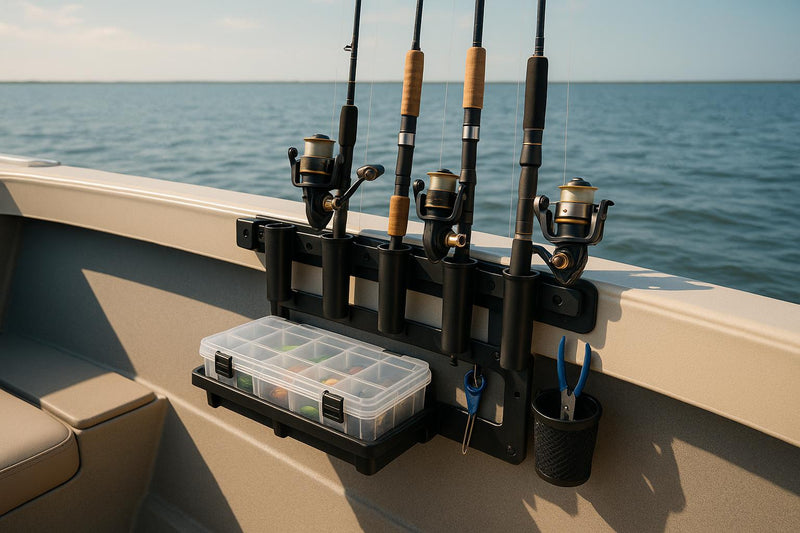When you're out fishing, having the right tools within reach can save time and improve your experience. Here’s a quick rundown of the five essential items every angler should carry in their quick-access pockets:
- Compact Multi-Tool: Combines pliers, cutters, knives, and more in one tool. Ideal for various tasks like unhooking fish or adjusting gear.
- Line Nippers or Scissors: Ensure sharp, clean cuts for tying strong knots and handling braided or monofilament lines.
- Small Waterproof Tackle Box: Protects your gear from water damage while keeping it organized and easy to access.
- Forceps or Hemostats: Perfect for safe hook removal and other delicate tasks like pinching barbs or tying knots.
- Leader Material Spool: Essential for quick line repairs, with options like fluorocarbon for abrasion resistance or monofilament for flexibility.
Each item is designed to improve efficiency and minimize downtime, ensuring you spend more time fishing and less time fumbling through your gear. Pair these tools with purpose-built fishing shorts featuring secure, accessible pockets for a comfortable and organized setup.
Fisherman’s Everyday Carry: Essential Gear for Every Angler!
Compact Multi-Tool: All-in-One Fishing Tool
A compact multi-tool is a must-have for anglers, combining essential tools like pliers, cutters, and hook removers into one sleek package. It’s perfect for saving space in your fishing shorts or mens fishing shorts, ensuring you’re always prepared without the bulk.
When choosing a multi-tool, look for models that pack needle-nose pliers, versatile knife blades, wire cutters, and screwdrivers into a durable, corrosion-resistant design. Features like needle-nose pliers are perfect for unhooking fish, while plain and serrated knife blades handle a variety of cutting needs. Wire cutters can manage heavy lines, and screwdrivers (both Phillips and flathead) are great for quick tackle adjustments.
Materials matter, too. Stainless steel or titanium construction ensures your tool can withstand exposure to water and salt, while one-handed operation is a lifesaver when you’re battling a fish and need to make quick fixes.
Your fishing style should guide your choice. Compact models are ideal for fly fishing, allowing you to pinch barbs, attach split shot, and tweak reels with ease. On the other hand, saltwater anglers might prefer sturdier pliers and stronger cutting tools to handle tougher conditions.
A good fishing multi-tool doesn’t just make life easier - it’s a smart investment. Affordable yet durable, it’s an upgrade that boosts both convenience and efficiency. Pair it with mens fishing shorts that have secure pockets, and you’ll always have your tool within easy reach, ready for whatever your fishing trip throws at you.
Line Nippers or Scissors: Clean Cuts Every Time
Blunt line cutters can throw a wrench in your fishing flow, especially during a quick lure change or when retying after a break-off. Sharp, dependable nippers or scissors stashed in an easy-to-reach spot can keep you in the game. Clean cuts aren't just about convenience - they're crucial for strong knots. Frayed line ends weaken your knots, and that could mean losing the fish you've been dreaming about.
When it comes to blade material, the right choice makes all the difference. Look for cutters made from stainless steel, high-carbon steel, or titanium-coated blades. Serrated or micro-serrated edges are especially handy for slicing through slippery braided lines. Titanium-coated blades, while often pricier, excel at resisting rust and holding their edge longer than standard stainless steel options.
Blade design also matters. Bypass cutters are preferred by many anglers because they deliver cleaner cuts compared to anvil-style designs.
Don’t overlook ergonomics - a key factor when you’re fishing in wet or cold conditions. Non-slip handles provide better control, and spring-loaded mechanisms can ease hand fatigue during a long day on the water. Features like lanyard holes, pocket clips, or included sheaths make it easier to keep your tools accessible and secure.
The type of cutter you need depends on your fishing style. Here’s a quick breakdown:
- Fishing scissors (sometimes called "braid slayers") are ideal for braided lines. They deliver precise, fray-free cuts and often feature comfortable grips.
- Fishing nippers or snips are compact, perfect for quick one-handed cuts on monofilament or fluorocarbon lines.
- Fishing pliers with built-in cutters offer versatility, though their cutting ability can vary. Some models may crush braided line rather than cutting it cleanly.
Prices range widely, from basic models to high-end tools designed for professional-grade performance and durability.
To keep your cutters in top shape, rinse, dry, and oil them after every use - especially if you’re fishing in saltwater. Quality nippers are compact enough to fit securely in the specialized pockets of Fishing shorts or Mens Fishing Shorts, keeping them protected and ready for action when you need them most.
Small Waterproof Tackle Box: Keep Gear Dry and Organized
Opening your tackle box only to find rusted or corroded gear can ruin any fishing trip. A small, waterproof tackle box eliminates this problem by keeping your gear dry and neatly arranged, ensuring you're always ready to cast your line.
"Water is the enemy when it comes to fishing tackle storage. There's nothing worse than finding your valuable fishing tackle in a tackle box full of water, and it's covered in rust."
Modern waterproofing technology has come a long way. The best tackle boxes now feature a 360° O-ring seal paired with tight-sealing cam latches, creating a durable barrier against water intrusion.
Customizable compartments make organizing your tackle a breeze. Take the KastKing HyperSeal Waterproof Tackle Box, for instance. Its 3700 deep model includes 33 adjustable dividers, allowing you to configure the compartments to fit your gear perfectly. Transparent lids make it easy to spot what you need, saving valuable time during those moments when every second counts. This user-friendly design also fits seamlessly into quick-access pockets on fishing gear, keeping everything within reach .
When selecting a waterproof tackle box, size and price are also key factors. Popular options come in 3600 and 3700 sizes, designed to fit most tackle bags and boat storage spaces. For anglers who fish from shore, these compact boxes are ideal for the functional storage pockets found in Fishing shorts or Mens Fishing Shorts. Prices range from $12.95 for budget-friendly options to $34.99 for premium models, with top-rated versions earning high marks for their durability and waterproof performance .
"The HyperSeal Tackle box is fully waterproof to prevent rust. It is shock and wear-resistant, and its sturdy frame with a heavy-duty locking latch prevents moisture from entering and protects fishing gear."
To keep your waterproof tackle box in top condition, rinse it after each trip, clear any debris from the seal, and let it air dry. Combine a reliable waterproof tackle box with well-designed Fishing shorts or Mens Fishing Shorts for quick access and organized gear, ensuring you're always ready for your next catch.
sbb-itb-cb0a783
Forceps or Hemostats: Safe Hook Removal Tool
Forceps and hemostats are must-have tools for safely removing hooks. While all hemostats are technically forceps, they include a ratchet locking mechanism, unlike standard forceps, which rely on manual pressure. Their slim, precise design makes it easier to access tight spots, allowing you to remove even the smallest hooks with minimal risk of injury to the fish or yourself.
When choosing forceps, go for high-quality stainless steel models. They resist corrosion in both saltwater and freshwater, ensuring long-lasting performance. Look for features like serrated jaws for a firm grip on slippery hooks and integrated needles for cleaning out hook eyes - both of which can make your fishing experience smoother.
Their slender design isn’t just functional - it’s convenient. Unlike bulky pliers, forceps can easily fit into the storage pockets of Fishing Shorts, keeping them accessible without adding bulk or discomfort. Tool length is another important factor. For smaller fish like trout, 5-inch forceps work well, while 7-inch models with curved tips are better suited for larger species like steelhead and carp.
Forceps aren’t just for hook removal. These versatile tools can pinch down barbs on hooks, straighten bent hooks after snags, assist with tying intricate knots, and even help organize your flies. Their multifunctionality makes them an essential part of any angler’s kit.
To keep your forceps in top condition, rinse them after every fishing trip to remove salt and debris. This simple habit ensures the jaws stay smooth and the locking mechanism remains dependable over time.
Anglers often prefer premium forceps for their durable construction, reliable locking systems, and comfortable grip. Studies have shown that proper hook removal significantly boosts fish survival rates.
For shore anglers, pairing durable forceps with well-designed Mens Fishing Shorts creates a practical setup. With essential tools always within reach, you’ll be ready for a seamless catch-and-release experience.
Leader Material Spool: Ready for Quick Repairs
Running out of leader material can bring your fishing day to a screeching halt. But keeping a compact spool in your quick-access pocket can turn those frustrating line breaks into nothing more than a minor hiccup. Whether it's abrasion damage or an unexpected snag, having your repair gear within reach means you can stay on the water longer and focus on the catch.
When choosing a leader material, consider the specific strengths of each type. Fluorocarbon is nearly invisible underwater, offers strong abrasion resistance, sinks quickly, and repels water. This makes it a top choice for clear water and high-abrasion conditions. On the other hand, monofilament shines with its natural stretch, providing excellent shock absorption. It’s also easier to tie knots with, making it ideal for intense battles with fish.
To keep your leader spools organized and tangle-free, check out Fishing shorts from Reel Comfort. These shorts are designed with secure storage pockets and reinforced stitching, offering a practical solution to safeguard your gear while wading.
Matching Leader Material to Conditions
The right leader material depends on the fishing conditions. For clear water or areas with high-abrasion risks, fluorocarbon is the go-to option. Its invisibility and durability make it perfect for nymphing or fishing near structures. For dry fly fishing or situations where you want the leader to float naturally, monofilament is the better choice. It’s also more affordable and easier to handle, making it a versatile option for general use. Be sure to select the correct pound-test strength to match your target species for dependable performance.
Keep in mind that temperature can impact how these materials perform. Fluorocarbon can stiffen in colder temperatures, making knots trickier to tie, while monofilament tends to weaken when exposed to moisture over time.
| Material Type | Best Uses | Key Advantages | Considerations |
|---|---|---|---|
| Fluorocarbon | Clear water, nymphing, structure fishing | Nearly invisible, abrasion-resistant, repels water | Stiffer, harder to tie, more expensive |
| Monofilament | Dry flies, shock absorption, general use | Stretchy, easy to handle, affordable | More visible, absorbs water over time |
Reel Comfort’s Fishing shorts are designed to keep your gear dry, organized, and ready for action. By carrying compact spools of both fluorocarbon and monofilament in the quick-access pockets, you’ll always be prepared to tackle unexpected repairs. With their smart storage design, comfort, and durability, these shorts are a game-changer for anglers who want to stay efficient and focused on the water. Add a spool of each leader type to your kit, and you’ll be ready for whatever the day throws your way.
Comparison Table: Quick-Access Pocket Items
When every second matters, the right gear in the right pocket can make all the difference between landing a trophy fish or missing the moment. To help you decide what deserves prime pocket real estate, here's a breakdown of five essential tools and how they compare in terms of size, weight, and functionality.
The compact multi-tool is your go-to for versatility, combining several tools into one handy device. Line nippers are lightweight champions, ideal for small pockets and quick, precise cuts. A small waterproof tackle box excels at keeping gear organized and dry but can hog space. Forceps and hemostats strike a balance between size and utility, offering precise control for tasks like hook removal. Lastly, leader material spools are compact and essential for quick repairs, provided you pick the right material for your fishing conditions.
| Item | Typical Dimensions | Weight | Durability | Frequency of Use | Key Advantages | Main Considerations |
|---|---|---|---|---|---|---|
| Compact Multi-Tool | 3-4 inches long | 3-6 oz | Stainless steel, high | High | All-in-one functionality | Heavier, can feel bulky |
| Line Nippers/Scissors | 2-3 inches long | Under 2 oz | Stainless steel, medium | High | Lightweight, precise, one-handed use | Blades dull over time, need upkeep |
| Small Waterproof Tackle Box | 4-6 x 3-4 x 1-2 inches | 4-8 oz (loaded) | Impact-resistant plastic, high | Medium | Keeps gear dry, organized visibility | Limited capacity, bulky when full |
| Forceps/Hemostats | 5-7 inches long | 1-2 oz | Stainless steel/aluminum, high | Medium | Safe hook removal, fine control | Awkward in smaller pockets |
| Leader Material Spool | 2-3 inches diameter | Under 2 oz | Varies by material, medium | Medium | Quick repairs, adaptable | Must match species and conditions |
For saltwater anglers, tools made of stainless steel are a smart choice - they resist corrosion better than other materials. Line nippers with replaceable blades last longer, while tackle boxes with waterproof seals and impact-resistant designs can handle rough use. Leader spools crafted from shatterproof plastic are ideal for frequent handling.
Frequency of use is another factor to consider. Multi-tools and line nippers are your most-used items, making them perfect for your most accessible pockets. Tackle boxes, forceps, and leader spools might not see action as often, but they’re indispensable when you need them.
Weight distribution is key to comfort during long fishing trips. Spread heavier items like multi-tools and loaded tackle boxes across different pockets to avoid discomfort. Brands like Reel Comfort design fishing shorts with strategically placed pockets to distribute weight evenly while keeping your tools secure and within reach.
Your fishing style also plays a big role in what you carry. Fly anglers might prioritize forceps and leader spools, while bass fishermen often rely on multi-tools and nippers. The trick is to pack your pockets based on what you actually use, not just what might come in handy.
Look for tools with features like magnetic or spring-loaded mechanisms, thumb studs, or locking handles. These designs make one-handed operation easier, especially when your hands are wet. Paired with thoughtfully designed Fishing shorts and Mens Fishing Shorts, these tools ensure you're always ready for action.
Conclusion: Get Your Quick-Access Pockets Ready
Having the right tools within arm's reach can turn a frustrating fishing trip into a seamless and enjoyable experience. A 2024 survey of recreational anglers revealed that over 70% found quick-access pockets significantly improved their efficiency and reduced wasted time on the water. When you’re dealing with a big catch or a snapped line, being prepared saves precious seconds.
The five essentials we’ve discussed - compact multi-tools, line nippers, small waterproof tackle boxes, forceps, and leader material spools - are the backbone of an efficient angler's toolkit. But even the best gear won’t do much good if it’s buried in a bag or hard to reach. A 2023 review highlighted that anglers with specialized fishing shorts experienced a 25% faster response when changing lures, thanks to their well-placed, functional pockets.
This is where purpose-designed fishing shorts shine. Unlike standard cargo shorts, which can become uncomfortable when wet or lack practical pocket placement, fishing-specific apparel is built for performance. These shorts feature multiple ergonomic pockets for easy access, water-resistant fabrics to keep tools dry, and even removable thigh pads for added support during extended battles with tough fish.
Comfort also plays a huge role. With even weight distribution and reinforced stitching, men’s fishing shorts keep your gear secure whether you’re casting, wading, or reeling in a fighter. Secure closures and durable materials ensure that your tools stay put, no matter how active your day on the water gets.
Although these shorts typically cost between $60 and $120, anglers consistently rate them 4.5 out of 5 stars for their comfort, durability, and accessibility. It’s an investment that pays off in both practicality and enjoyment.
Before heading out on your next fishing trip, take a moment to organize your gear. Place frequently used tools like multi-tools and line nippers in your primary pockets, while backups like leader spools and forceps can go in secondary ones. And don’t forget to test your setup with wet hands - it’s the best way to ensure everything is truly ready when it counts.
FAQs
What should I look for in a compact multi-tool for fishing?
When picking a compact multi-tool for fishing, look for one that suits your specific tasks, such as cutting fishing lines, tightening gear, or making minor repairs. Choose a model that's sturdy, resistant to corrosion, and equipped with essentials like pliers, blades, and screwdrivers to handle exposure to water. A compact design is crucial so it can easily slip into your pocket or fishing vest for quick access.
To make your fishing trips even smoother, consider pairing your multi-tool with practical fishing apparel. Well-designed fishing shorts with specialized pockets can keep your tools handy, ensuring you're always prepared without fumbling around.
What’s the difference between fluorocarbon and monofilament leaders, and when should I use them?
Fluorocarbon leaders are prized for their strength, density, and resistance to abrasion, making them an excellent choice for fishing in tough environments like areas with heavy cover, jagged rocks, or sharp structures. Another big advantage? They’re less visible underwater, which is a huge plus when fishing in clear water or trying to catch wary fish. The downside is that fluorocarbon can be stiffer, which might make tying knots a bit trickier.
Monofilament leaders, however, offer greater flexibility and stretch, which helps absorb the shock of sudden strikes or the struggle of a fighting fish. They’re also easier to handle and tie, making them ideal for beginners or for situations where visibility isn’t a big issue - like in murky water or during low-light hours.
To sum it up, go for fluorocarbon when you need strength and subtlety, and choose monofilament for its flexibility and user-friendly handling.
How can I keep my fishing tools, like line nippers and forceps, in good condition, especially when fishing in saltwater?
To keep your fishing gear like line nippers and forceps in top shape while fishing in saltwater, start by giving them a good rinse with fresh water after every use. This helps wash away salt and prevents corrosion. After rinsing, make sure to dry them thoroughly to avoid rust caused by lingering moisture. A light application of lubricant or a corrosion inhibitor can add an extra layer of protection to the metal parts.
Taking the time for regular maintenance - cleaning, drying, and lubricating - will keep your tools dependable and extend their lifespan, even when exposed to the challenges of saltwater environments.




